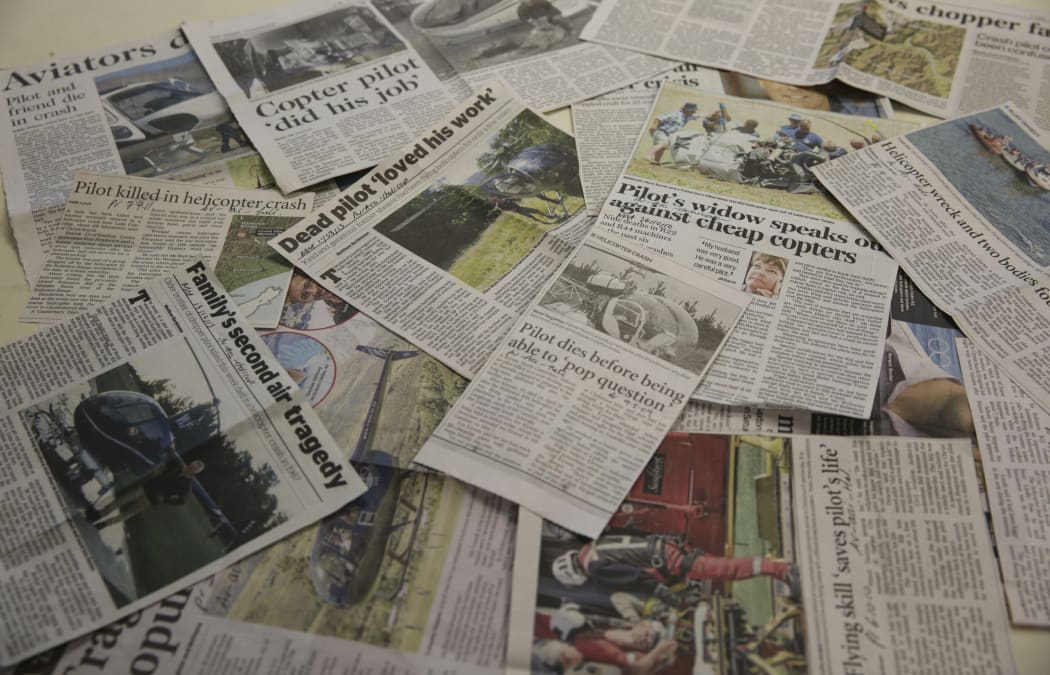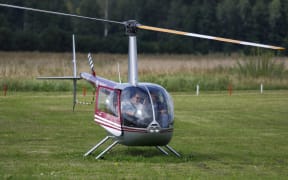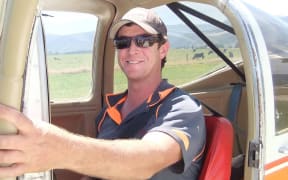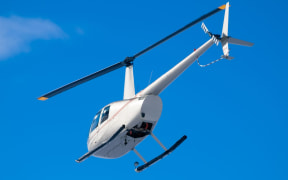Robinson helicopter representatives are set to visit New Zealand after the Department of Conservation banned some models because of safety concerns.

A collection of newspaper clippings of Robinson helicopter crashes over the years. Photo: RNZ
Representatives from the company are set to visit New Zealand again in a fortnight, Aviation NZ said, to talk about new safety programs for their choppers.
The Department of Conservation permanently banned the use of Robinson R22, R44 and R66 models by staff last week.
New Zealand has had a significantly higher rate of low-G mast-bumping accidents in some Robinson helicopter models than in other parts of the world - about nine times higher than the US, according to the Transport Accident Investigation Commission (TAIC).
Robinson Helicopter Company data provided to the TAIC shows the number of low-G mast bumping accidents which have occurred in New Zealand and the United States since 2000 is the same even though there are 300 helicopters in New Zealand's fleet compared to 2700 in the US.
DOC is just the latest organisation to ban the helicopters, which have featured in 143 helicopter crashes in New Zealand since 2000 - 21 of which were fatal.
Those 21 accidents make up 48 percent of the total fatal helicopter crashes in the 17 years between 2000 and 2017.
R22 and R44 models were flown for 901,682 hours in that time - 32 percent of the total helicopter flight time - 2,843,848 hours.
Other organisations to stop using the helicopters include Environment Canterbury, Environment Southland and the Bay of Plenty Regional Council.
The Civil Aviation Authority of New Zealand (CAA) has investigated 14 fatal Robinson crashes since 1991 caused by "mast bumping", contact between an inner part of a main helicopter blade and the main rotor drive shaft, which usually results in the helicopter breaking up in flight.
It found that nine of those crashes were in low-G conditions.
Robinsons make up about 35 percent of the helicopters in New Zealand.
In October 2016, they were added to the transport safety watchdog's watchlist with the highest possible warning.
The CAA maintains its view the helicopters are still safe to fly - when flown by experienced, trained pilots within the manufacturer's recommended limits.
The CAA said the rate of fatal accidents occurring in Robinson R22, particularly involving in-flight break-up of the aircraft, between 2006 and 2016 was of significant concern.
But said the rate had since reduced noticeably, after new rules introduced in July 2016 requiring a minimum of 20 solo flying hours, and safety courses every two years for some pilots.
Those rules were brought in following a review of the helicopters' safety after a crash in 2014.
The exact cause of the crashes is the matter of some debate. Robinson executives consistently claim it is down to pilot error, including differences in training.
TAIC found one crash in 2014, which killed pilot Damian Webster, was caused by mast-bumping, exacerbated by strong winds.
Robinson Helicopter Company rejected the report, saying it was probably down to training. Mr Webster had 287 hours flying experience, but just 11 hours in total spent flying the R44 model.
At the time, the commission's chief investigator, Tim Burfoot, said a Robinson helicopter break-up accident had occurred every 18 months since 2002.
Another crash in October 2016 prompted the US lawyer for families of the victims to say the helicopters were "unsafe and unairworthy".
It was that crash which prompted DOC to initially suspend use of Robinsons, now extended to a permanent ban.
Company president Kurt Robinson visited New Zealand in April 2016 to personally investigate the high crash rate, and said the company was putting in a special efforts to find the reasons why.
A spokesperson for the Robinson Helicopter Company said they were disappointed with DoC's decision. The company wasn't contacted by do, or involved in the decision making process, they said.
Robinson Helicopter Company director of flight safety Bob Muse will be in the country at the end of next week and will be meeting with government agencies and other groups to discuss the safety of the helicopters.





